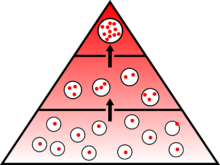Bioaccumulation
Bioaccumulation is the accumulation of a substance in an organism through absorption from the surrounding medium or via food (see food chain ). The term bioaccumulation is used both for the process of accumulation and for the designation of the instantaneous or equilibrium state reached.
Bioaccumulation as a physiological process
Bioaccumulation can relate to a chemical compound (such as DDT ), a chemical element (such as lead ), an isotope (about 90 Sr, the radioactive strontium -90) or particularly small particles (so-called nanoparticles ). Bioaccumulations mainly occur with substances that have a long biological half-life, which means that they are neither rapidly broken down or converted biochemically nor quickly excreted. If the concentration in the external medium (water, soil, food) drops again, the level of bioaccumulation in the organism often gradually decreases again, although the decrease is time-delayed and often only incomplete.
The phenomenon of bioaccumulation is not limited to pollutants, but also occurs with essential biochemical compounds (such as vitamins) and chemical elements (such as minerals). An example of this is the bioaccumulation of vitamin A in the liver of predators, such as polar bears , which feed on other predators ( seals ).
Bioaccumulation factor
The relative level of the substance concentration in an organism compared to the surrounding soil, the surrounding water or the ingested food is called the bioaccumulation factor. This represents a dimensionless quantity that reflects the ratio of the concentrations in the two comparison compartments .
Specifically, the bioaccumulation factor is the relationship between the concentration in the body and a reference medium, such as the surrounding soil, the surrounding water or the food consumed. If a specific bioaccumulation factor is given, the physical reference value in the two compared compartments must always be given, because the concentrations for the two compared compartments should refer to the same measured variable, for example fresh mass, dry mass or volumes. A volume-related bioaccumulation factor of 1000 compared to water means that the concentration in the organism is a thousand times greater than in the surrounding water if both comparison values are related to the respective volumes. Bioaccumulation factors can also be given for individual organs in comparison to a reference compartment. For example, high-fat organs (such as the liver) often have higher concentrations and thus higher bioaccumulation values of lipophilic environmental pollutants than low-fat organs (such as muscles). Heavy metals often accumulate at certain binding points in the body, such as lead (as Pb 2+ ) by displacing calcium (as Ca 2+ ) in the bones.
Biomagnification and Bioconcentration
In many cases, bioaccumulation is conceptually subdivided into bioconcentration , which represents the pure absorption from the environment via body surfaces (absorption via the gills is important for many aquatic organisms) and biomagnification , which represents absorption through food. The different importance of these two entry pathways is sometimes difficult to determine in practice, as the absorption paths often run parallel (e.g. in the case of aquatic organisms) and the respective level of bioaccumulation in the organism is in balance with the breakdown or excretion of the substance from the body.
PBT properties
PBT ( persistent, bioaccumulating and toxic foreign substances ) are defined as organic, persistent, bioaccumulating substances with toxic properties that have adverse effects on humans and the environment . PBT information is contained in safety data sheets .
Sequestration
The sequestration of toxins by animals is a special form of bioaccumulation .
Individual evidence
- ↑ P. Egeler, M. Meller, J. Roembke, P. Spoerlein, B. Streit, R. Nagel: Tubifex tubifex as a link in food chain transfer of hexachlorobenzene from contaminated sediment to fish. Hydrobiologia 463: 171-184 (2001).
- ↑ Strategies for the detection of persistent, bioaccumulating, and toxic foreign substances (PBT) - Lecturer: K.-W. Schramm, GSF Research Center for Environment and Health, Neuherberg Thursday July 12, 2007 .
literature
- Bernd Beek: Bioaccumulation - New Aspects and Developments . The Handbook of Environmental Chemistry Vol. 2. Springer, Berlin 2000, ISBN 978-3-540-62575-9 .
- Karl Fent: Ecotoxicology . Georg Thieme, 3rd edition, Stuttgart 2007, ISBN 978-3-13-109993-8 .
- Jeffrey M. Neff: Bioaccumulation in Marine Organisms. Effect of Contaminants from Oil Well Produced Water . Elsevier 2002, ISBN 978-0-08-043716-3 .
- Paul R. Paquin: Metals in Aquatic Systems: A Review of Exposure, Bioaccumulation, and Toxicity Models . SETAC Foundation. ISBN 978-1-880611-50-0 .
- Bruno Streit: Bioaccumulation of Contaminants in Fish . Pp. 353-387. In: Thomas Braunbeck u. a .: Fish Ecotoxicology . Birkhäuser, Basel 1998.
- Bruno Streit, Werner Stumm: Chemical properties of metals and the process of bioaccumulation in terrestrial plants. Pp. 31-62. In: Bernd Markert (Ed.): Plants as Biomonitors. Indicators for heavy metals in the terrestrial environment. VCH Publisher, Inc., Weinheim & New York 1993, ISBN 978-3-527-30001-3 .
